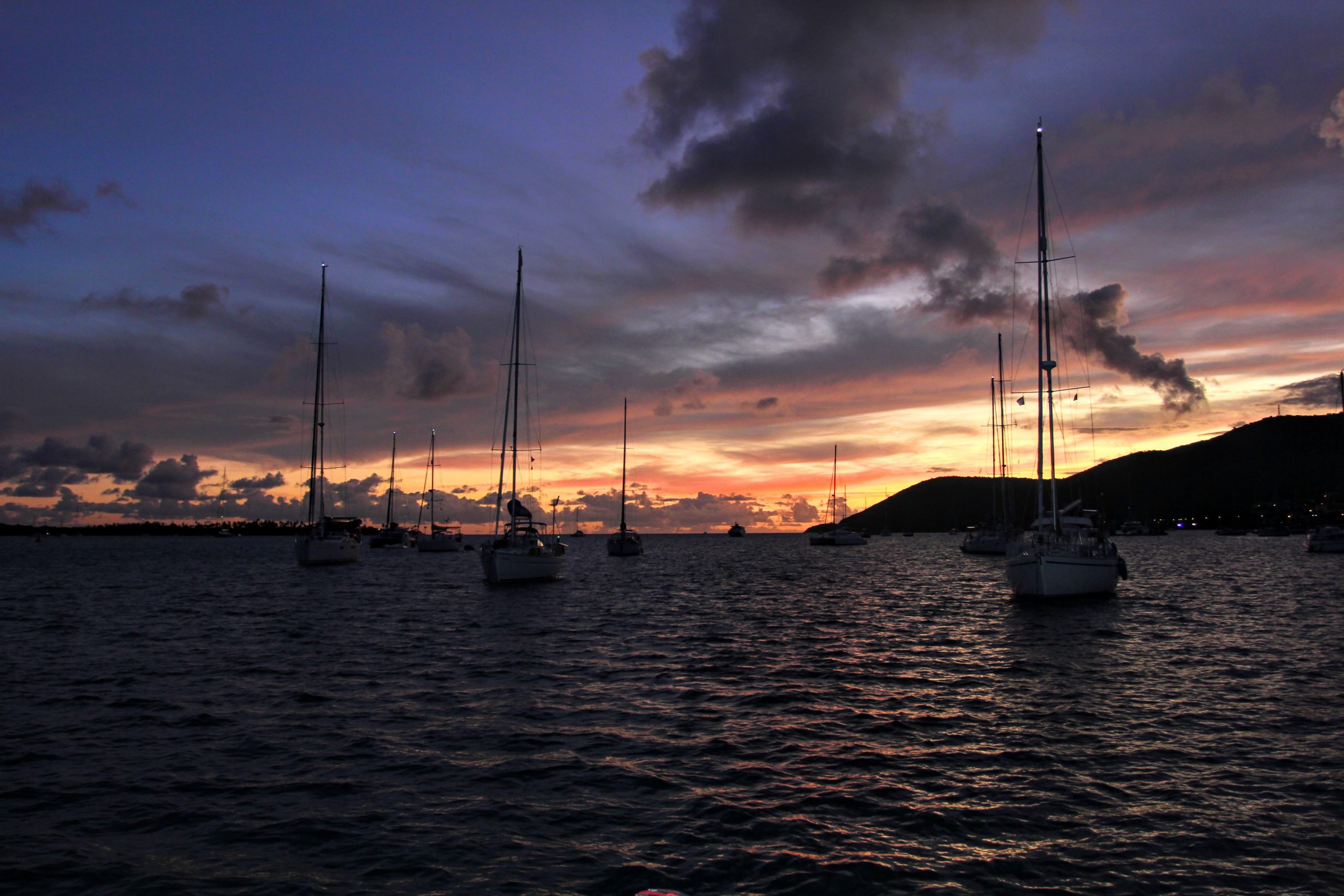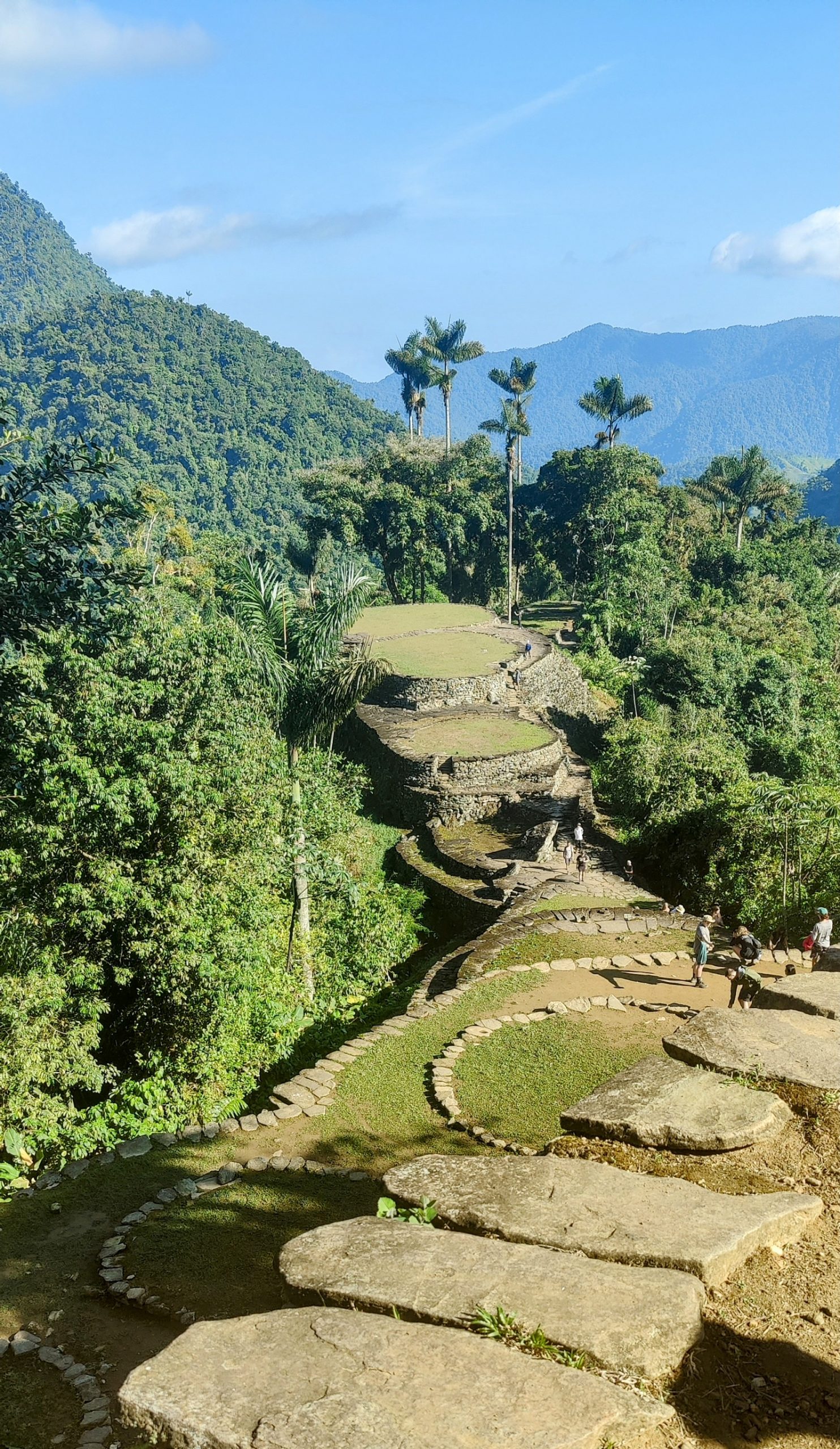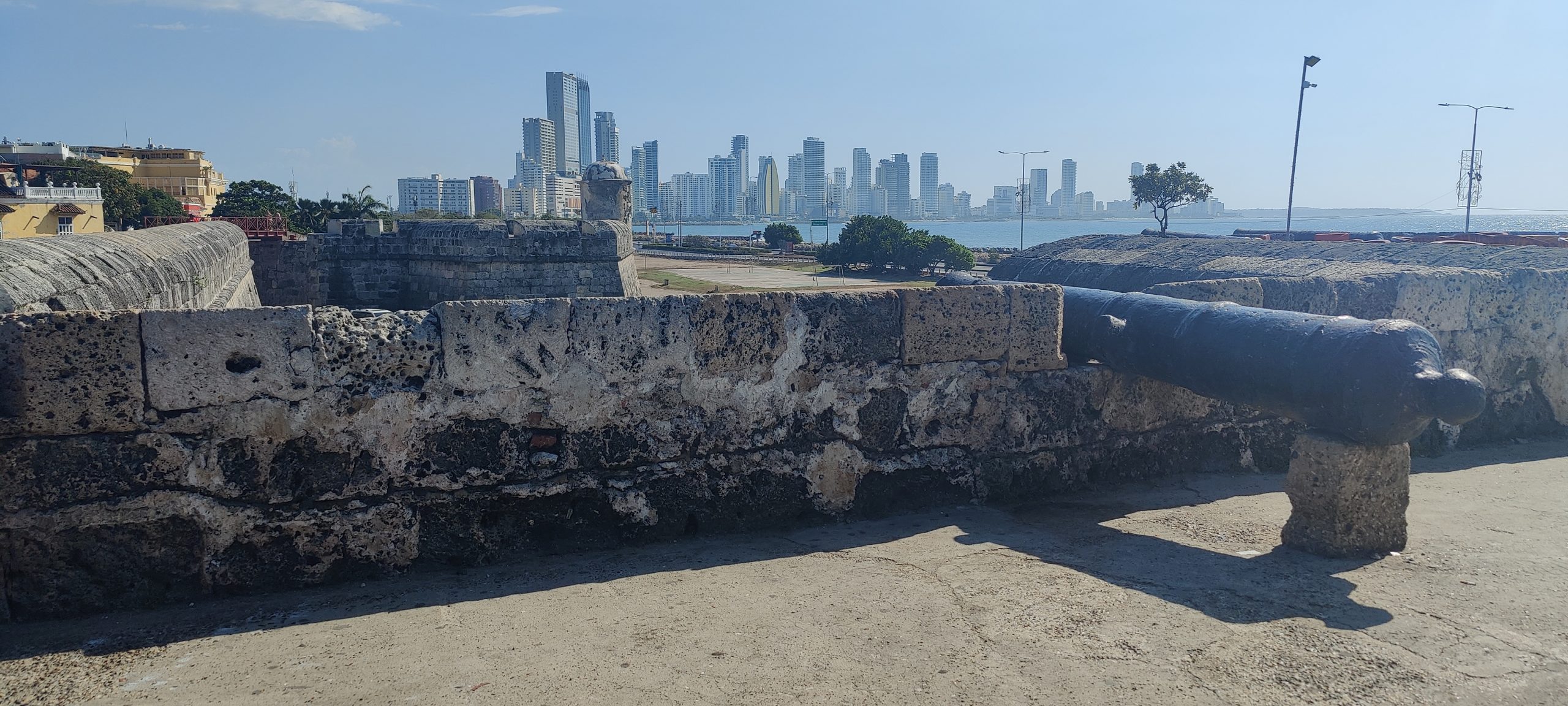We have now been in Le Marin in Martinique for over a month. We did plan to have a long stop here, because if you need things fixed on your boat in the Caribbean, this is one of the places to get it done. Le Marin has many chandleries as well as a workshop at the marina and a large shipyard. Although we had plan to be here for a month, we arrived in high season, and the mechanics were all very busy.
To start with we anchored just outside the marina. After a few days we once again had problems with our black water tank. It has given us nothing but trouble. We thought we had gotten it fixed in Grenada, but it turned out, we hadn’t seen the last of the problems yet. One of the days after Martin had been to the toilet, we could hear the bilge pump running. We opened up to the bilge and could see a fountain standing out of the tank. A lot of salt water had leaked into the tank and after the flushing it built up pressure and started leaking.
We took the dinghy into the marina and complained our distress. Surely they had to make room for us. We couldn’t anchor now. But they didn’t have a spot for us. Instead we were allowed to buy access to their sanitary facilities. Then we just had to take the 5-10 minute dinghy ride in every time one of us had to go. Not a great service, but better than nothing.
Once we got into the boatyard, we had mechanics look at it and they were able to patch the tank. At some point in the near future we will probably have to invest in a new tank. There aren’t any tanks to be found here in Martinique, that meets our requirements. It will have to be a project for Guadeloupe or the US Virgin Islands.
Martin has wanted for a long time to have repaired or replaced the inverter that burned down on the first leg of the Atlantic crossing from Las Palmas to Mindelo. We have all missed that inverter. The workshop by the marina initially accepted to repair the old inverter, but later said that they only repaired a certain brand of inverters, which is one of the expensive brands. After a few days thought, Martin went up and bought the very expensive inverter. He installed it in the starboard engine room, where the batteries are mounted. It’s hard to see in the picture, but the black cables for the inverter are 95 sqaure milimerters. He had to borrow a massive bolt cutter and a crimping tool from the shop to join the wires.
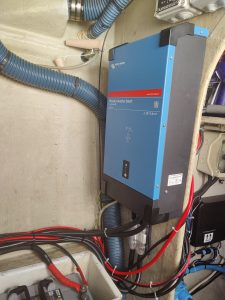
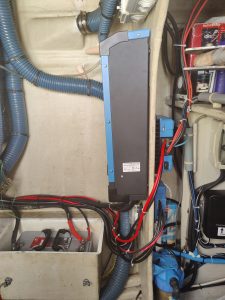
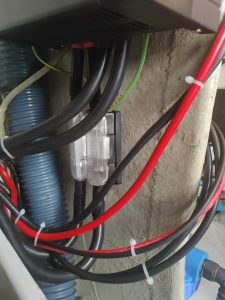
Once he got down there, one thing led to another and he ended up cleaning and removing meters and meters of cables from previous instruments. The picture shows just some of the cables, that were removed.
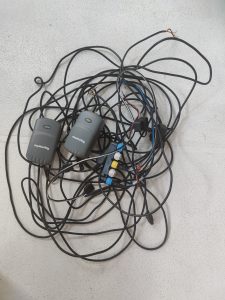
The new inverter has worked impeccably and given us access to stable and fast internet, because now we have the option of having 220V to power the Starlink when we are at anchor. Everyone is happy!
Another thing on our wish list was new solar panels. The brand new installation we got in Spain doesn’t provide enough power for our consumption when we sail. We need to run both the fridge and the freezer 24/7, and when we’re sailing, we also need power for the sailing instruments, not to mention the autopilot. One of the reasons is that we had all the instruments replaced in Spain. The new instruments draw considerably more power than the old ones did. Martin did some research and found some flexible solar panels that would work for us. In one of the stores, he asked for solar panels, the guy wouldn’t give him any prices on new equipment before he ran some checks on our existing setup.
First of all, a reading of Voltage loss from the Mppt to the batteies. Second, Thickness of cables from MPPT to Battery Third, upgrade and test of the MPPT (this he did for free at the shop). Apparently it’s quite common to have voltage loss between the MPPT and the batteries. Martin got some new thicker cables, and moved the Mppt closer to the batteries to minimize voltage loss. This gave a little more power, but not enough, so we bought new solar panels anyway. Martin managed to install them by himself with a new MPPT between the panels and the batteries.
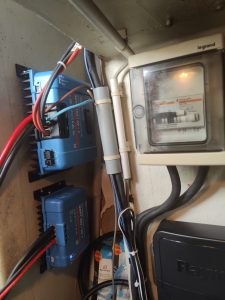
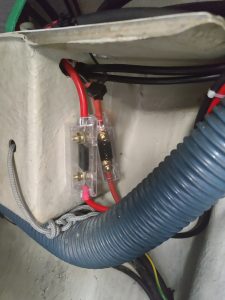
The placement of the panels was a bit trickier. He had envisioned them being put on the bimini, but the ones we bought didn’t have holes in the corners like many of the other flexible solar panels have. The solution was velcro! We put velcro on the edges of the solar cells. The other end of the velcro had to be put on some fabric flaps sewn onto the bimini. Once the solar panels are attached and in place, the flaps with velcro can be folded over the solar panels to hold them in place. We had the flaps sewn with velcro at a local seamstress, but sewing them onto the bimini is quite a task when you don’t have a sewing machine. It started with Martin and Elliott taking one solar panel and Victor and I the other. But Victor ran tired of it, and now Martin and Elliott is finishing it off by having one person sit on top of the bimini and the other stand underneath, receiving and returning the needle in best Cinderella cartoon style, where the mice sew the dress for Cinderella that way.
At the shop, where we bought solar panels, we also found the PH balancing filters for the watermaker, that we’ve been looking for since we purchased this boat. The demineralized water from the watermaker passes through the filter, and is enriched with the minerals and salts, that are usually contained in tap water.
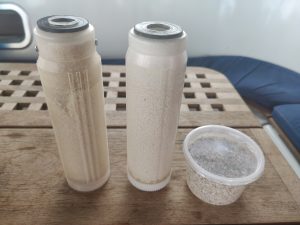
We had also hoped to get our generator fixed here. It broke while we were sailing from Mayreau to Bequia Christmas day. During sailing, we wanted to make some water. Martin ran the generator to supply 220v to the watermaker. After a short time the generator stopped. It couldn’t reach the 240v needed for it to run. When we arrived at Bequia, he googled that it was probably a capacitor that had gone. He pulled out a spare capacitor, the generator started and he got some water made. Unfortunately it wasn’t the whole solution to the problem. The generator still didn’t reach high enough voltage. At one point, smoke began to come out of a relay for the watermaker. After that he couldn’t start the watermaker again. When he tried to turn on the generator at a later time, it stalled as soon as load was applied to it. To sum up, the generator was broke and in the attempt to make it work, we also broke some parts of the watermaker.
In Le Marin, Martin found the realy for the watermaker and changed it himself. It was little expensive, but an easy fix. You can see the old realy in the left photo and the new one on the right.
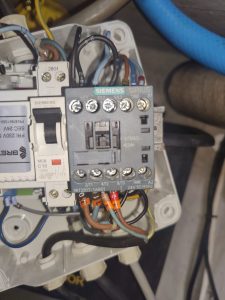
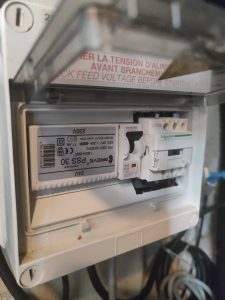
A mechanic in Le Marin had a look at the generator, and concluded the same as Martin had already googled. We need a new stater coil for the generator. Since it will take more than a month to deliver to Martinique, we will wait til we get to the US Virgin Islands, where we probably will be able to get one delivered from Fort Lauderdale.
Another source of power supply is our wind generator, which works very well in the Caribbean. There is always wind here. At one of our first sails before leaving from Spain, we had troubles with the boom being in collision with the wings on the wind generator. Martin and Anton tilted the wind generator a bit to avoid that. Over time it has damaged the wind generator to be tilted. It has become very loud.
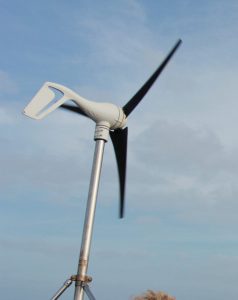
Martins and my cabin is just below the wind generator, and we can hear it all night long. In Le Marin, with all the time we had, waiting for various mechanics, Martin separated, lubricated and erected the wind generator vertically. It’s a little better than before, but it still gives about 70db in our cabin. Martin believes that the ball bearings probably have been damaged from tilt. Next step will be to change bearings and get new carbon fiber wings to reduce the noise. Perhaps we can get that in US Virgin Islands as well.
Apart from all the big upgrades and repairs, we’ve also done maintenance like rust removal, and while we had the rental car for a week, we also provisioned for the next long while. There is a good selection here and the prices are better than in the previous Islands, we’ve visited in the Caribbean. Now we have enough canned food, flour and pasta for several months. We’ve also been collecting gear for maintenance, for example sanding papers, gelcoat repair kit etc. There are lots of spots on the boat where the gelcoat has been worn off by the running rigging. Especially the parasailor rigging, which the boat is not really built for, has worn a lot on the boat.
We’ve been talking about the next part of our journey, and whether we’re going through the Panama Canal and to the Pacific. We need crew to sail with us. So far we haven’t searched for crew, as we needed a functioning boat first. For the next while we will be planning routes, searching for crew, getting an agent for Panama Canal and perhaps one for visiting the Galapagos.
